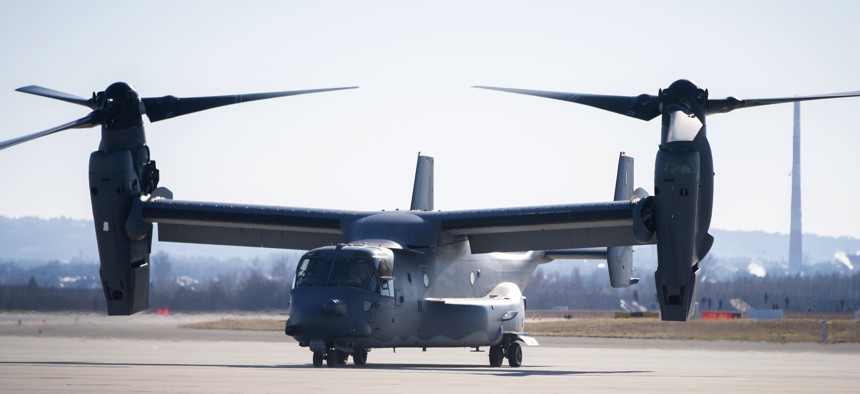
U.S. Air Force Bell-Boeing V-22 Osprey landed at Rzeszow-Jasionka Airport in Poland on 13 February 2022U.S. Air Force Bell-Boeing V-22 Osprey landed at Rzeszow-Jasionka Airport in Poland on February 13, 2022. Mateusz Wlodarczyk/NurPhoto via Getty Images
The Air & Space Brief: USAF’s future-fighter deals; V-22s still down, HARM missiles to Ukraine
Welcome to the Defense One Air and Space newsletter. Here are our top stories this week:
Ensuring future fighters: The Air Force has awarded identical contracts to five warplane and engine manufacturers—Lockheed Martin, Boeing, Northrop Grumman, General Electric, and Pratt & Whitney—to ensure those firms can compete to build the next generation of fighter jets, Marcus Weisgerber writes. Each firm received $975,000,000 to work on propulsion for the future plane, including “technology maturation and risk reduction activities through design, analysis, rig testing, prototype engine testing, and weapon system integration.”
V-22 update: The Air Force’s V-22s remain in stand down while service leaders decide how to handle hard clutch engagement, the service said in a statement. Some Air Force Osprey crews were given a one-time waiver to fly their grounded Ospreys back to their home station, a spokesman for U.S. Air Force Special Operations Command told Defense One. Meanwhile, here’s how the Marine Corps, which has known about the problem since 2010, deals with it: “We have trained our pilots to react with the appropriate emergency control measures should the issue arise during flight.”
HARM missiles to Ukraine: The U.S. confirmed it has sent Ukraine HARM anti-radiation missiles to target Russian radar sites, and also announced another major round of security assistance on Friday. The missiles had not been previously identified, but Ukraine has installed the weapon on its Soviet-made MiG fighter jets. “When we first announced the initial provision of HARM missiles, the way that we characterized it in the announcement was not specific. We described that we were providing a counter-radar capability…we do want to be careful about how we talk publicly about capabilities that will give Ukraine a significant asymmetric and unexpected advantage,” a senior defense official told reporters Friday.
American astronauts still in Russia: Despite Russia’s July announcement that it will withdraw from the International Space Station program, there’s still training cooperation between the two countries going on. NASA will air a live interview Wednesday with ISS Expedition 68 NASA astronaut Frank Rubio from the Gagarin Cosmonaut Training Center in Star City, Russia.
Sign up to get The Air & Space Brief every Tuesday from Tara Copp, Defense One’s Senior Pentagon Reporter. On this day in 2006, Pluto got downgraded from its position as the smallest planet in the Milky Way galaxy to just a “dwarf planet,” according to the International Astronomical Union.
 From Defense One
From Defense One
The Hardest Thing About Missile Defense in Guam? Finding the Right Site // Lauren C. Williams
There are candidate locations, but nothing is final, said Missile Defense Agency Director Vice Adm. Jon Hill.
Marine Ospreys Still Flying, Despite AFSOC Stand Down // Caitlin M. Kenney
Marine Corps says it has known about the hard clutch issue for 12 years, and is trained on how to respond to the failure.
Sensing Russian Stall, US Rushing Arms to Help Retake Ukrainian Territory // Marcus Weisgerber and Tara Copp
The latest weapons package includes MRAPs with special landmine-clearing devices–and brings the total to $10.7 billion.





